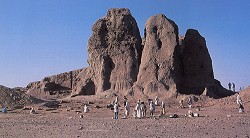
Kerma is an area on the eastern bank of the Nile, south of the third cataract. In the period 1913-1916, G.A. Reisner discovered a previously unknown Sudanese culture there, known as the Kerma Culture. The origins of the Kerma Culture are still rather obscure. We do know that the cultures of the A and C groups and of groups from the Eastern desert, the Sahara and Upper Egypt were all influential. Kerma was located in one of the most fertile parts of the Nubian Nile Valley. The economy was based on agriculture and animal husbandry, but even more important was its location on the trade routes that linked Egypt with the rest of Africa.
There was already a settlement at Kerma in the late fourth millennium BC. In the late Old Kingdom, Egyptian traders travelled to the 'land of Yam', which probably refers to the region of the Kerma Culture, and the inscription of Harkhuf suggests that it was already a well-organized kingdom, whose ruler controlled the route northwards from eastern and central Africa.
The high point of the city of Kerma was in around 2400 BC, and it remained occupied for a further thousand years. The heart of the city was a structure now known as the western Defuffa, a local term for a mud-brick structure. It was probably the most important religious building in Kerma. In shape it resembles an Egyptian temple, consisting of a tower-like structure with a rectangular block behind it. Inside the Defuffa there was only a narrow corridor and a stairway leading to a flat roof. In the Classic Kerma period (c. 1750-1600 BC), the Deffufa and its workshops and other buildings were surrounded by an enclosure wall, thus forming a religious quarter. In the southwest of the city was another large, round building, which perhaps served as a royal audience chamber.
Craftsmanship in Kerma was of a very high quality, particularly in the field of bronze-working and the manufacture of faience. Beautiful jewellery was also made there. However, the most characteristic product of Kerma is its pottery, which is of a very high quality. In the Classic Kerma period, large numbers of 'tulip beakers' were produced. They have a round bottom and a flared neck, very thin walls and a regular shape. Characteristic is the silver-grey band that separates the reddish-brown coloured lower part from the black rim and the inside. The most beautiful pieces were usually found in the large tumulus graves. These had become steadily more elaborate and well-filled, an indication of the prosperity of Kerma. The tombs were hill-shaped with a burial chamber underneath where the body of the deceased was laid on a bed dressed in beautiful clothes and jewellery.
At the time of the Egyptian occupation of Lower Nubia, Kerma was the capital of the most important African state besides Egypt, and was known by the Egyptians as Kush. It is clear from the measures that the Egyptians took to make Lower Nubia a buffer zone just how much of a threat they regarded the Kushites to be. A boundary stela of Senwosret III may be insulting about the enemy, but it nevertheless exhorts constant vigilance. The kingdom of Kush reached its apex in the late 17th century BC, when the Egyptians had to withdraw from Lower Nubia as a result of internal conflicts and the invasion of the Hyksos in the Delta. The Kushites pushed northwards and occupied the forts at the 2nd cataract, as well as a number of other strategic positions as far north as Aswan. At the beginning of the New Kingdom, King Ahmose and his son Amenhotep I reconquered Lower Nubia. The heart of the Kushite kingdom remained intact until the reign of Thutmosis I, who crushed the power of Kush with a major campaign in his second regnal year and probably sacked Kerma. Thutmosis then returned home with the dead body of the Kushite leader tied to the prow of his ship. For the next fifty years rebellions were a constant factor in the south, and only under Thutmosis III did the Egyptians succeed in completely subjugating all of Nubia.